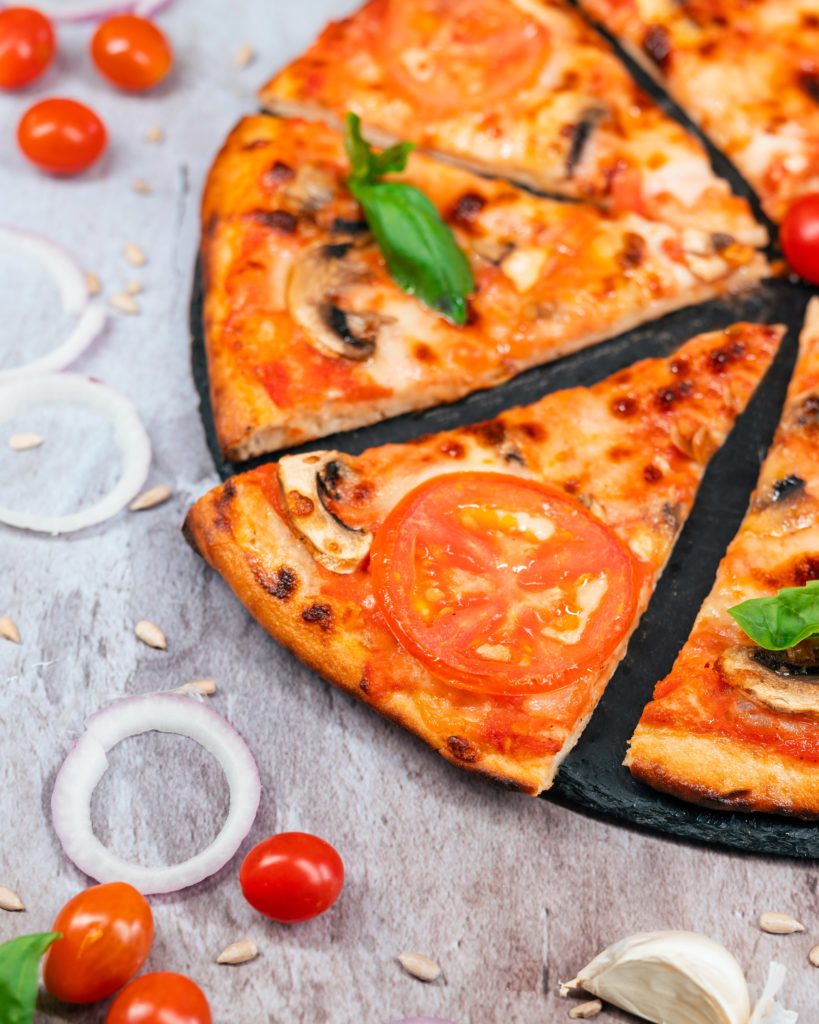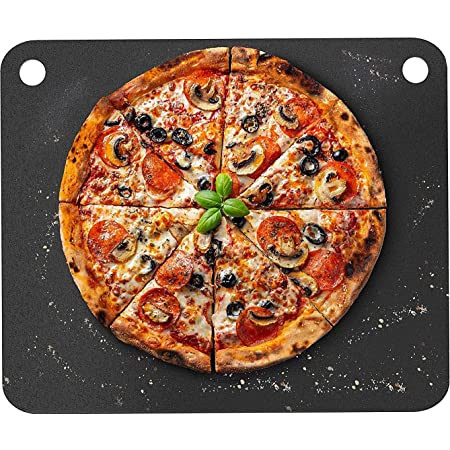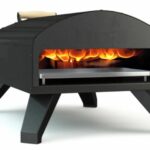The Best Fluffy Pancakes recipe you will fall in love with. Full of tips and tricks to help you make the best pancakes.
Pizza Steels

Traditional pizza ovens generate heat over 500 – 600.C. This heat quickly cooks certain styles of pizza in under 90 seconds. Home ovens can only manage to reach temperatures of 230-250.C. Making it difficult to recreate a pizza base as good as your favorite pizza restaurant. However, by adding either a pizza stone or pizza steel to your oven can help by adding a surface which is designed to transfer heat directly into your pizza base, and can replicate the results a traditional wood fired pizza oven creates.
Pizza stones have been for a number of years, used in home kitchens to help replicate traditional pizza oven pizzas in home ovens. Usually made from clay, ceramic or composite materials, pizza stones, when used in a home kitchen, can help generate the heat directly into your pizza base. Pizza stones attempt to recreate the hot environment of a wood fired pizza oven, when used in your home oven.
The drawback to pizza stones are they are easily broken, and really don’t generate entirely enough heat required to create certain styles of pizzas.
Clay and ceramic pizza stones can be prone to cracking, chipping and even shattering when dropped or banged when washing. The can also be affected by thermal shock and shatter when cooled or heated too fast.
Pizza steels (also known as baking steels) act similar to pizza stones, however are made from steel, not clay or ceramic as with pizza stones. Pizza steels are great at conducting heat when they are heated, with the steel absorbing ,storing and transferring heat quickly and efficiently.
The way pizza steels conduct heat, would be one of the most significant reasons why home pizza aficionados are turning towards replacing their pizza stones for pizza steels.
Most pizza styles are designed to be cooked for the shortest amount of time at high temperatures. As a Pizza steel heats, it retains the heat, the heat of your oven isn’t wasted trying to heat the pizza steel, and instead this combined heat energy is radiated directly into the pizza base, cooking it faster and hotter then a traditional pizza stone.
When you add a pizza to an oven, as the pizza cooks, the moisture in the pizza dough will be transformed into rapidly rising steam. Combined, with the carbon dioxide gasses created during fermentation, will cause your pizza base to become puffy, light, airy and crispy. The greater amount of heat your pizza is exposed when cooking will speed up this process and creates a perfect pizza base.
When using a pizza stone in a typical home oven, the heat generated cooks a pizza in around 5-8 minutes. Which is fast compared to not using a pizza stone, however it still is not fast or hot enough to recreate a pizza as good as your local pizzeria. Pizza Steels however, with their greater heat conductivity, transfer heat faster to the dough, and within 3-4 minutes your pizza base is not only cooked, to a crispy and airy perfection, but full of bigger gas bubbles that any master pizzaiolo would be proud of.
Pizza Steel Construction

The thicker your pizza steel, the greater the thermal mass and greater the thermal mass of your pizza steel, the faster you pizza will cook. But lets not get to carried away, the thicker the steel, the heavy it becomes, and we don’t want your home oven buckling under the excessive weight of a hot piece of steel that cant be handled without industrial equipment.
So how thick should a pizza steel be? Well, commercially available pizza steels, made with commercial food grade steel, range in thickness from 6-15mm and weighing anywhere between 4 and 10kg. Sizes range from square and round with the average dimensions being 30-35cm x 30-35cm. For best results in your home oven, it is suggested a pizza steel of 8-12cm is ideal. You should be able to generate enough heat with your home oven set to 230-240 C. to recreate your favorite restaurant style pizza.
Cooking with your Pizza Steel
As with pizza stones, you need to preheat your pizza steel before using. Depending upon your oven it is best to place it on your oven rack ½ way or 2/3rds from the top of your oven. The thicker your pizza steel, the longer it takes to heat up. Set your oven to 230-240.C, place your pizza steel into your oven, and close the door. Different pizza steel thicknesses will need different heating times to preheat.
A pizza steel around 6-8mm will take around 45 minutes to 1 hour to preheat before use. Thicker pizza steels 10-15mm thick will take at least 1 ½ hours of preheat time before you can cook on them. And remember that if cooking multiple pizzas, your steel is going to need recovery time to allow the steel to reheat before cooking on again, so allow 5-10 minutes before adding your next pizza base.
When cooking your pizza on your pizza steel, your pizza (depending on toppings – and remember don’t go and add to many toppings) should be cooked within 3-4 minutes. If your toppings are not quite cooked but the base is, you may need to reposition your pizza steel closer to the top of your oven, for the ovens radiate heat to cook the pizza toppings. It may take some practice with your oven before you get your pizza perfect.

Caring for your pizza Steel
Once you have finished cooking your pizza, turn off your oven and allow your pizza steel to thoroughly cool down, this can take 1-2hrs. Remember, to wear oven mitts when handling your pizza steel, and DO NOT touch whilst its being used or cooling, the pizza steel gets scorching hot when heated.
Once out of the oven, place your steel onto a wooden cutting board. Using a dry cloth lightly wipe off any residue off the pizza steel.
If require washing, only use water to clean the pizza steel, do not use any soaps and detergents. Use a hard nylon brush and water to scrub your pizza steel. Immediately wipe your pizza steel dry with a tea towel and never allow your pizza steel to air dry as this can cause rust from forming on the surface of the pizza steel.
Most pizza steels already come pre seasoned, however after time your pizza steel may need to seasoned again. To do this, wash your pizza steel with soapy water (only use soap when seasoning your pizza steel) and scrub with a wire brush. Rinse off any soap residue and wipe dry. Apply flax seed oil with a paper towel, making sure to coat both the top and bottom of the pizza steel. Lightly wipe off any excess oil with a paper towel. Preheat your oven to 220-240.C and place your pizza steel onto a oven rack positioned in the middle of the oven. Heat pizza steel for 1 hour, then turn off the oven. Allow the pizza steel to cool completely before removing from the oven.
Pizza steel Conclusion
As I mentioned at the beginning of this article, when you eat your favorite pizza from your favorite restaurant or pizzeria, it has been cooked in a commercial pizza oven which can reach temperatures of over 500-600.C. If you are trying to recreate your favorite pizza at home, your home oven just cant reach the temperatures that are required for some pizza styles, notably Neapolitan and New York style pizzas.
For many years home chefs turned towards pizza stones in hope these would help generate the required heat needed for these pizza styles, and in some way pizza stones do improve the home made pizza, but do not replicate the pizzas of restaurants and pizzerias.
Enter the pizza steel. A pizza steel performance is a close as a home oven can come to creating a commercial pizza oven style pizza.
When placed in a hot home oven and heated , pizza steels absorb ,store, transfer heat quickly and efficiently. As many of the pizza styles people enjoy baking at home are designed to be cooked for the shortest amount of time at high temperatures, the pizza steel can create an environment suited for creating a perfect pizza in your home oven.



